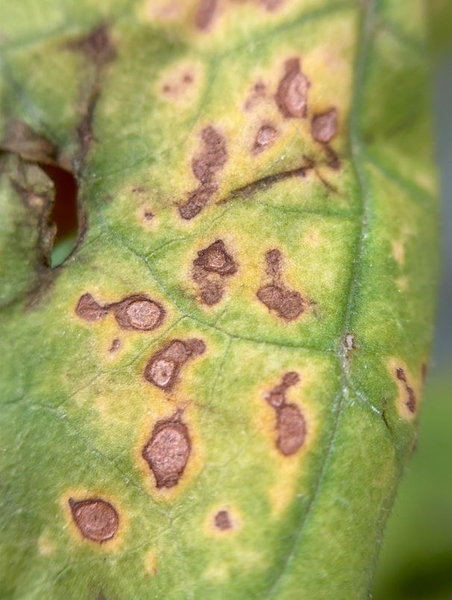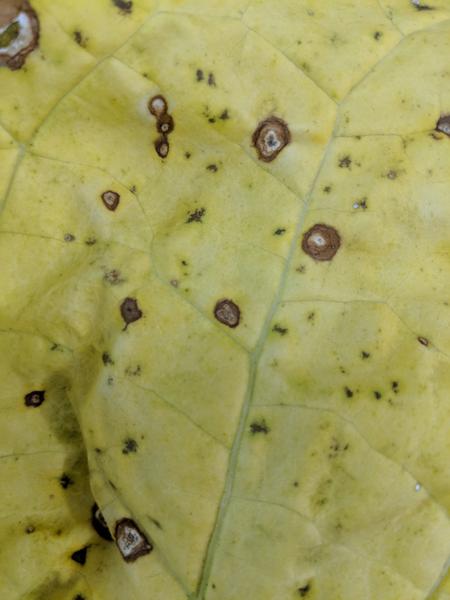Introduction
Brown spot is a potentially devastating foliar disease of tobacco in North Carolina. Brown spot of tobacco has been observed in China, India, and the southern United States. The disease has caused sporadic losses and quality reductions in American tobacco, since it was first reported in North Carolina in 1892. The disease is caused by Alternaria spp. spores from the soil-borne fungus are released from the soil surface onto mature leaves closest to the ground, causing circular, water-soaked lesions that turn brown and expand outward in an irregular pattern. The disease will spread upward in warm, humid conditions on older tobacco plants.
Pathogen
The causal agents of brown spot are Alternaria alternata or Alternaria longipes, which are opportunistic pathogens of many crops, including apples, beans, beets, brassicaceae, cotton, cucurbits, pears, peppers, potatoes, strawberries, tomatoes, wheat, and many other common host plants . The pathogens survive in crop debris and disperse as conidia (asexual spores). Conidia germination requires moisture for germination and colonization of host tissue. Once tissues are colonized, abundant conidia are formed within lesions that are later dispersed to new tissues.
Symptoms
Small circular to irregularly-shaped spots, beginning small (0.25 in) and expanding as they mature (1.25 in). Lesions are dark brown with yellow halos surrounding the spots (Figure 1). Within the lesions, dark rings may be observed that contain thousands of spores that may be splash- or wind- dispersed to newer leaves. Lesions may coalesce, causing the necrotic tissue to tear away, leaving the leaves ragged. Brown spot can continue to develop under curing conditions, causing moldy growth on cured leaves called fungal barn rot.
Diseases with Similar Symptoms
Target Spot
(Thanatephorus cucumeris, syn. Rhizoctonia solani) (Figure 2)
Target spot lesions are not limited to mature leaves. Spots are brown with concentric rings and lack spores.
Frogeye Leaf Spot
(Cercospora nicotianae) (Figure 3)
Frogeye leaf spot lesions affect leaf tissues and may appear similar to early brown spot lesions. Frogeye leaf spot is characterized by small white lesions with yellow halos and black spots in the center (spores).
Phytophthora Leaf Spot
(Phytophthora nicotianae, causal agent of Black Shank) (Figure 4)
Leaf spots caused by Phytophthora nicotianae are limited to the lower leaves and will not spread upward. The lesions are dark brown with concentric rings, but do not contain dark, brown spores like brown spot.
Disease Cycle
Alternaria spp. survive on crop debris or other weedy hosts. Conidia production begins when warm, moist conditions are present in the spring. Alternaria spp. conidia disperse onto leaves via air currents or water, and germinate when conditions are moist (rain or nighttime dew), and warm (25 - 32°C). Spores can enter through wounds, the stomata, or directly through the top of the leaf, infecting the leaf within 12 hours. New production of conidia can occur in as few as ten days after the first symptoms appear and can continue for a long period of time thereafter, as long as conditions remain conducive.
Management
Brown spot management relies on cultural practices aimed at reducing fungal inoculum in the field and the delay of initial disease onset. There are no effective, registered chemical products for brown spot in tobacco.
Exclusion and Sanitation.
The pathogen can be moved in infested soil via equipment, vehicles, tools, or shoes that have entered the field. Equipment from fields with black shank should be sanitized before moving to unaffected fields. Workers should also sanitize shoes after working in infected fields. Working in fields with known histories of black shank last will reduce time and effort needed for sanitation of equipment.
Field sanitation is an important step in managing this disease and reducing its spread. Destroying stalks and roots quickly after harvest will help reduce inoculum. Contaminated irrigation or runoff water may also aid in its movement within a field or from one field to another. Improving drainage in areas where water pools can reduce the environmental suitability of the soil.
Plant Health.
Infections by other pathogens that impact general plant health may also increase brown spot incidence. High nematode pressures, black shank, and Granville wilt may also increase brown spot. Limit nematode and other disease pressures where possible.
Adequate nutrition (not deficient nor excessive) for encouraging vigorous growth of leaves and limiting excess growth may reduce the impact of brown spot. Additionally, proper plant spacing and sucker control will limit humidity in plant canopies, reducing brown spot incidence.
Useful Resources
The NC State University Plant Disease and Insect Clinic provides diagnostics and control recommendations.
The NC State Extension Plant Pathology Portal provides information on crop disease management.
The North Carolina Agricultural Chemicals Manual provides pesticide information for common diseases of North Carolina. The manual recommendations do not replace those described on the pesticide label, and the label must be followed.
The Tobacco Diseases Information page, created by the Shew lab at NC State University, provides in depth information on several tobacco diseases found in North Carolina.
For assistance with a specific problem, contact your local N.C. Cooperative Extension agent.
Publication date: Sept. 27, 2019
Reviewed/Revised: July 3, 2024
The use of brand names in this publication does not imply endorsement by NC State University or N.C. A&T State University of the products or services named nor discrimination against similar products or services not mentioned.
Recommendations for the use of agricultural chemicals are included in this publication as a convenience to the reader. The use of brand names and any mention or listing of commercial products or services in this publication does not imply endorsement by NC State University or N.C. A&T State University nor discrimination against similar products or services not mentioned. Individuals who use agricultural chemicals are responsible for ensuring that the intended use complies with current regulations and conforms to the product label. Be sure to obtain current information about usage regulations and examine a current product label before applying any chemical. For assistance, contact your local N.C. Cooperative Extension county center.
N.C. Cooperative Extension prohibits discrimination and harassment regardless of age, color, disability, family and marital status, gender identity, national origin, political beliefs, race, religion, sex (including pregnancy), sexual orientation and veteran status.




